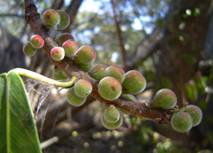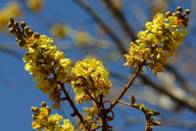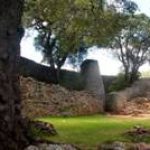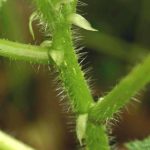TREE LIFE
February 1982
MASHONALAND CALENDAR
Tuesday February 2nd : Botanic Garden Walk. Meet in the Car Park at 1645 hours for 1700 hours.
Sunday February 21st : Banket District. “a visit to Nkodzwi Farm by kind invitation of Mr. and Mrs. John Duffield where we will be guests of the Ayrshire Branch. There are well treed granite kopjes with a bonus of rock paintings.
BOTANIC GARDEN WALK – 5TH JANUARY 1982
Having started our walk and having looked at one rare tree the heavens opened and we did a quick dash to the Herbarium where Mr. Tom Muller was able to continue entertaining and instructing us, this time on the beauty and value of Botanic paintings and drawings. Thank you Tom for again rising to the occasion.
DANBURY PARK FARM SUNDAY 17TH JANUARY 1982
The weather again looked down on Sunday 17th January, saw that the Tree Society was having an outing to the Mt Hampden area, smiled and arranged for the rain to fall elsewhere. Whether Bobs and Tom Bayley, our hosts for the day, were disappointed to see rain fall elsewhere or not I am afraid I did not ascertain. However, they had no reason to be disappointed in our turn out, there were 33 in the bus and at least another 10 or 12 came independently. And we thought that when the outing was close to “Salisbury not many people attended. Also I do not think that anyone who was there was disappointed because it was another lovely day. It was intended that we should start the day with tea at the farmhouse but as it was early when we arrived and Tom was keen that we should see his “wishing tree” we postponed tea and off we set. The first part of the walk was through a most unusual grove of Combretum molle, recognisable by its very velvety soft leaves which gives it its name, Velvet-leaved Combretum and molle means soft. Most of these were heavily in fruit in various stages of development. The flowers borne densely in spikes about 5 – 9 long are greenish yellow and sweetly scented. It must have been quite a sight when they were all in flower and probably also it would have been an entomologists dream as the flowers attract the insects as well. I think it is a little unusual to see an almost pure stand of larger than usual Combretum molle. As small stunted trees on highly mineralised soil they are quite often encountered as pure stand because of their toxic mineral tolerance. But there was nothing like that here.
Also in profusion were Peltophorum africanum, African wattle, again mostly in heavy fruit at the yellow to tan stage, but one still had a few flowers for us to admire and examine. Peltophorum has fine compound leaves and can be confused with Albizia amara (which we also saw) but it has dense rusty brown velvety hairs on the growing tips and distinctive rusty fern-like stipules.
Near our destination we found the Bead-bean, Maerua angolensis in green pod. Flora Zambeziaca described the fruit as narrowly calendric and torulose and that super word means “with small swellings; beaded.” Only it does not describe the fact that the constrictions between the beads/beans are irregular. Several people asked what the flowers are like and I think they can best be described as a powder-puff having no petals and looking rather like an Albizia flower, but with longer stamen. What we did not know about and therefore did not look for, were swellings on the petiole (leaf stalk) just next to the leaf. We did notice how long the petioles were this is a member of the family CAPPARACEAE as are Capparis and Boscia.

Ficus burkei. Photo: Bart Wursten. Source: Flora of Zimbabwe
The wishing tree was lovely; two fig trees which had fused together forming an arch through which we walked and wished. For the purist identifiers there were Ficus burkei, Common Wild Fig, with small fruit borne in the axils of the leaves. We also saw Ficus sycomorus, sycamore Fig, with its rough leaves and the figs borne on the branches and Ficus capensis Cape Fig, with smooth wavy-edged leaves and the figs borne on special branchlets on the trunk of the tree.
After tea which, because we had already had a walk, was even more welcome than usual, we climbed into the bus and went ‘over the other side’ to the area near the site of the original homestead, where there has been nothing chopped within living memory and certainly we saw no re-growth. What we did see were the most enormous Pittosporum viridiflorum. I believe they were as large as most of us have ever seen and they all had pale trunks with pustule like lenticels in rough horizontal bands which Alec Dry recognised immediately having seen them thus in the Matopos. In the literature available to me at home I have found reference to this fact and actually found fewer popular write-ups on Pittosporum than I would have expected. Other species are well known garden plants and the name, therefore should be familiar. I have no hesitation in suggesting that for P. viridiflorum there can be no better common name than Pittosporum or Wild Pittosporum, as it is the only indigenous one in the country.
We wandered up to high point from which we were able to admire a view of the Mazoe Valley with the dam in the distance, a view we had already admired in the house as a Joan Evans painting. To our left was the original garden where Captain Pattison was buried. He had come to this country with the 1890 Pioneer Column and been given the farm in recognition of his services as were other members. After he died John Dunlop (who it is believed swam the Lundi River to show the Pioneer Column the way) bought the farm from Captain Pattison’s estate. John Dunlop at that time owned Mt Hampden Farm but sold it and moved to Danbury Farm in preference. His son Campbell took over the farm from his father and Tom Bayley joined him as a farm assistant in 1936. Ultimately when Campbell Dunlop felt he no longer wanted to farm, Tom Bayley was able to buy the farm from him and has since bought part of Mt Hampden Farm also.
Going back to our high point; some members went down to the spot of old garden and others wandered along the rocky ridge to the right. The highlight there was a large rock-splitting fig which demonstrated its ability to split rocks by lifting a sizable piece right apart from the parent body. We also saw Tapiphyllum velutinum, the Velvet leaf. Velutinum comes from the Italian velluto, meaning velvet, so both the common name and the specific name are appropriate. We found some fruit which is velvety too, and there were a few ripe ones tallow and orangy-brown. They consisted of a seed about 2.5mm in diameter, covered with little flesh and I am hoping to add this to my list of seedlings. We also came upon a grove of Ochna schweinfurthiana; the bark was too rough to be O. pulchra which has a peeling bark and the leaves were too large for O. puberula. Another highlight was seeing Hymenodictyon floribundum even without any sign of flowers. Tucked under a rock was our friend Leptactina benguellensis; the ground cover with Gardinia like flowers which had been so prevalent at the Casewell’s farm, Wicklewood, near Theydon. This time it was in fruit which are elongated, orange, about 2.5cm long and crowned conspicuously with the remains of the persistent calyx, so similar in shape to miniature fruit to Gardenia ternifolia.
After lunch we went up Mt Hampden. For the lower part of the climb some walked and some went by truck. At that stage we were on the part of the mountain owned by Tom Bayley. All who wished to go on to the top from where the road stopped, climbed through a fence on to Glenara Estate land and climbed on. The top was quite bare of trees (has it always been like that?) and we were able to admire a 360 ⁰ view. There were the Glenara Estate buildings to the east, the Mazoe Valley to the north and the flat patch-work farm land all around, mostly covered by misty rain which was a pity because on a clear day one is supposed to be able to see aircraft taking off and landing from the Charles Prince Airport and also the pearl on the top of Pearl Assurance Building in Salisbury.
We went back to the farm house for a thirst quenching tea and then we had the pleasure of Bobs Bayley giving us a guided tour of her very special shade-houses where she gave us full benefit of her knowledge on Anthuriums, Bromeliads and especially her ferns.
Our friends at the Herbarium are away at the moment so identification of our two mystery trees; the ? Xeroderris/?Ekebergia of the before-morning tea walk and the rock-splitting fig will have to wait until they return.
Finally thanks you to Mrs. Lola Irvine for arranging such a lovely outing and to Bobs and Tom Bayley for having us and making us so welcome.
LEUCAENA LEUCOCEPHALA
Leucaena leucocephala, hereafter referred to by its common name Leucaena (variously pronounced Loo-see-na, Loo-kee-na, Loo-kay-na and Loo-kuy-na) is, originally a native of Mexico.
Recently we have received a number of enquiries about the use of this very rapid-growing tree which could seem to be the answer to our fire-wood problem, so some facts and figures are timely which Paul has correlated for me.
Dick Petheram writes – “I first became interested in this as a result of an article in Time magazine in December, 1979. It was a ‘rave’ article describing the tree as capable of growth to 65 feet in 5 years and as providing ‘a bountiful array of food and fuels’. Other virtues described were: soil enrichment through the roots, use as a timber for building houses and making furniture and also for paper pulp. In mid 1981 I saw it in cultivation in West Java; the children chewing the pods. Enquiry in Zimbabwe indicates that the plant is on trial here ‘by Forestry for timber and fuel purposes and by Conex and Devag as fodder’. He goes on to say that it seems our soils are rather more acid and our mean average temperatures are on the low side for it to do really well.
A publication by the United States National Academy of Science says that it is a plant with probably the widest assortment of uses: nutritious forage (very rich in protein), firewood, timber, rich organic fertiliser, windbreaks, firebreaks, ground cover to stop erosion and ornamentation. Individual trees have yielded the highest annual totals of wood ever recorded and as a fodder it is responsible for some of the highest weight gains in cattle feeding on forage.
As a human food its young leaves and small pods are eaten raw as candy or cooked in soups, etc.; mature seeds are roasted and young dry seeds are ‘popped’ as popcorn. It is not recommended for extensive use as it contains a toxin, mimosine (see later).
Under good soil and moisture conditions 1 hectare of Leucaena (mowed to a height of 1 metre every 3 months) can provide foliage containing 500 to 600 kg of nitrogen in a year and, as its roots are as deep as the tree is high, they absorb mineral elements from deep soil layers which are distributed throughout the plant. The foliage harvested in Hawaii during one year contained 44kg of phosphorus, 187kg of potassium as well as calcium and other minerals. The leaves drop profusely and, being small and Acacia-like, decompose rapidly releasing their elements into the soil. Trevor Gordon reports that he grew Leucaena in conjunction with another crop and did not have to fertilise at all.
However, there is the other side. As a Forestry Commission spokesman said in the local press in November, 1980 “Despite recent enthusiastic but ill-informed articles in some popular magazines, Leucaena is not a world-wide panacea for the rapid production of fire-wood and forage. Like all plants, it has its own particular requirements for climate and soil. At first examination typical varieties (in the botanical sense of the word typical – ED) appear distinctly unsuited to most parts of Zimbabwe. It prefers alkaline soils and will not thrive in acid soils, and it requires a hot wet tropical climate, for instance an annual rainfall of 1 500mm or more and all the year round temperatures such as might be experienced at Beira. These climatic conditions are only approached in this country in very limited areas along the high rainfall strip on our Eastern Border below 900m.”
There is another very big snag. The plant contains mimosine, an uncommon amino acid that is toxic to non-ruminants (such as children) at levels of about 10% in the diet and to ruminants (such as cattle) if it is fed in excess of 30% of the total diet for prolonged periods. Symptoms are general ill health, loss of hair, drooling, poor growth and often goitre.
Recently a member of Grasslands Research Station said that there were three species being tested at the moment in Zimbabwe and trials are taking place all over the country. It will probably be more successful in our hotter areas such as Kariba and Chiredzi. In Botswana it has been most successful where it is grazed by cattle from March to May but it is very frost tender and the first frosts flatten it to ground level.
So it has its pros and cons. On the whole it seems to require less frost, a higher average temperature and a more alkaline soil than we have in most areas here, but reports say that there are hundreds of species in Mexico so obviously there is a lot of research to be done yet. Meg has been promised seedlings of three species and has been given seed of Leucaena leucocephala. If anyone would like to be involved in trying this out I know that their co-operation and help would be welcomed at official and society level.
-P. Coates Palgrave
AYRSHIRE BRANCH ANNUAL GENERAL MEETING HELD ON 19TH NOVEMBER, 1981.
1 It was agreed that the Tree Society should not become a “pressure group” re the cutting of indigenous timber as this was now a political issue and the Government, the N.R.B. and Parks and Wild Life were doing all that could be done about the matter.
2 In her report, the Acting Chairman said that the Branch had not been inactive during the year; members had attended the Tree Society A.G.M.at Mr. Trevor Gordon’s farm near Darwendale and had joined up again with Salisbury members to Spelonken, near Mazoe in June. In August a cocktail party welcomed Paul and Meg Coates Palgrave on a visit to the Branch and a field trip to the Hunyani River on Mafuta Farm, Raffingora, took place the next day culminating in a visit by the Coates Palgraves and Mrs. Graves to Gomo Estate.
3 The following officers were elected : chairman – Mrs. G. Henderson, Secretary – Mrs. B. Graves, Committee – Mesdames Fardell, Gilmour, Jones and Malan, Messrs Barron and Moore.
4 Under Any Other Business it was decided that one of the Branch projects for the New Year would be to seek out and destroy Mauritius thorn, which was a serious potential pest.
MATABELELAND BRANCH CALENDAR
Sunday February 7th : Following the January field meeting to Burnside Circular Drive, we are invited to investigate somewhat similar vegetation and should meet at 135 Crouch Road, Matsheumhlope where Miss v. Deas lives. Morning only.
Sunday March 7th : Nyamandhlovu road where there is a variety of soil types and vegetation. Meet at City Hall carpark at 0830 and bring lunch.
ANNUAL GENERAL MEETING HELD ON 4TH DECEMBER 1981
It was decided that for 1982 the Branch would be run by a Chairman and Secretary, and leadership of monthly field outings would be rotated amongst Branch Members. Mrs. Webb and Miss Webber will be the officers.
In her report the Vice Chairman said that they had parted with Brian Best, the previous Chairman, reluctantly and Salisbury is now the richer for his considerable knowledge and enthusiasm. The monthly outings had been maintained unbroken and habitats have been as varied as possible ranging from Kalahari sand through Acacia Woodland to Matopos vegetation, this latter varying from Brachystegia to Mopane.
They have had two visits during the year from the tree Society Chairman, Meg Coates Palgrave and her husband Paul. These were really enjoyable occasions and the opportunity to get to know her and to keep in touch with the parent body was welcomed. Tree Life is being read by all with increasing enjoyment.
The Branch depends heavily on Janet Webber and she was thanked for all she had done because, without her, the Branch would not be able to keep going, as she shoulders problems and difficulties so that members are not aware that they exist and her enthusiasm and dedication are the mainspring of the Branch.
JANUARY OUTING TO BURNSIDE CIRCULAR DRIVE
This is an area sometimes called “little Matopos” because of the small granite kopjes it is a ring road around southern Bulawayo and its height gives distant views across the plains. We were fortunate to have Mr and Mrs Coates Palgrave to share their intimate knowledge of trees with us. The biographist Monica Hutchings writes : the season is firmly advanced and a gnarled old withy tree has broken into delicate new green…” and if one substitutes Cussonia or Diplorhynchus the description fits though less poetical. It was an overcast day and ideal for walking and we found blossom on Schrebera alata, Acacia rehmanniana, Ziziphus mucronata and Osyris lanceolate. On Vitex payos we saw both cream and mauve flowers on the same shrub. Sadly the flowering of Pterocarpus rotundifolius was past, this year it has been an unforgettable sight – it has flowered heavily. We saw two Ximenia – africana and americana,

Peltophorum africanum. Photo: Bart Wursten. Source: Flora of Zimbabwe.
Peltophorum africanum with fruit well set. Sericanthe andongensis as a tall woody tree, the seldom seen Commiphora africana, and a well grown Erythrina latissima with long Loranthus branches trailing almost to the ground. In the kopjes we found interesting trees such as Berchemia zeyheri, Olea europea (sub.sp. africana), and Ficus burkei, F. ingens, F. glumosa with F. capensis nearby. The highlight of the field meeting was being introduced thoroughly to Tapiphyllum velutinum – one mature specimen of which had such fascinating layers of fibrous brown bark and clusters of green fruits. I notice in the Botanical dictionary that the Matabeleland name of umviyo is used for this tree and for Vangueria spp, but not in other dialects. Side by side we found both Clerodendrum glabrum and C. myricoides and so many other things – Strychnos spp. And Maytenus including M. undata, Elephantorrhiza elephantine grew profusely (ref. “Wild Flowers of Rhodesia” by Plowes and Drummond for photograph of flowers); Parinari curatellifolia and Protea gaguedi being (I believe) indicative of underlying rock and poor drainage. On a Protea branch was a wasp nest of mud measuring 60 x 100mm (how the discipline of measuring leaves comes in useful). Wild flowers too were spectacular, tall Anemones and Veld Violets, but Gloriosa surperba is late this year. I know for a fact that several members did some homework after this meeting, which in itself betokens a successful day.
-Janet Webber
I should like to add how much Paul and I enjoyed the outing and to thank all concerned for making us so welcome. To us the excitement of the day was Berchemia zeyheri and Elephantorrhiza elephantine to which we were introduced for the first time. MCP
I am delighted to say that the long awaited NRB Publication “Common Trees of Central Watershed Woodlands of Zimbabwe” by Robert Drummond is at last available and enclosed with this Newsletter is an order form. I have no hesitation in recommending it to any one interested in trees.
Those who were present at Matabeleland Branch Meeting on 3rd January and those who were on the bus to Danbury Park Farm have seen the Society’s copy. Unfortunately at present there are no plans for it to be available in Bookshops so please make use of the order form. As the books are sent registered post there is some delay between ordering your copy and actually receiving it.
Errata : TREES OF SOUTHERN AFRICA BY KEITH COATES PALGRAVE
“Less than 5% of names have been changed” – not 50% as appeared in the last Newsletter, so “the book is still 95% accurate”
-Meg Coates Palgrave Chairperson
COMMON TREES OF THE CENTRAL WATERSHED WOODLANDS OF ZIMBABWE by ROBERT B. DRUMMOND
The Natural Resources Board of Zimbabwe, assisted by the generosity of fifty one I.C.A. Committees and Natural Resources Sub-committees, the Conservation Trust of Zimbabwe, the Tree Society of Zimbabwe, the Wildlife Society of Zimbabwe and Mr. O.C. George, has published this authoritative and superbly illustrated, yet simple book on some of the commoner and more useful trees of the woodlands of the central watershed.
The book contains one hundred black and white line drawings by Mrs. Olive Anderson of the flowers, fruit and leaves of the trees which Mr. Drummond has so clearly described in adjoining text, together with a comprehensive table of flowering and fruiting periods for these trees and the complete National Tree List.
The book has a soft cover of green plastic and is most suitable for use in the field.
It is a must for all lovers of our indigenous trees.
The book is obtainable from the Director of Natural Resources, P.O. Box 8070 Causeway, Salisbury. At a cost of $5.0, payable by cheque or postal order. In the case of out of Salisbury cheques bank charges must be added, please. All the money collected from the sale of the book will be used to publish the next volume on Common Trees of the Lowveld.
All books purchased will be sent to purchasers by registered post.



